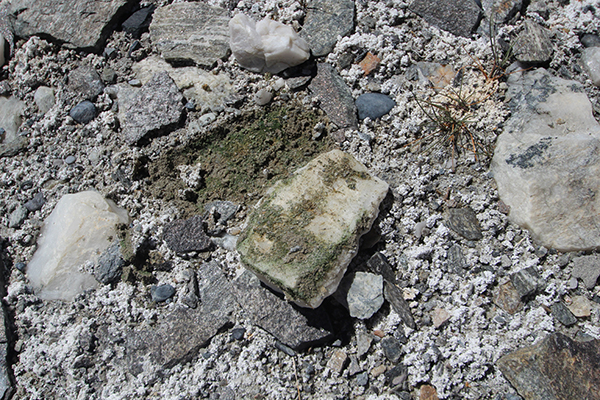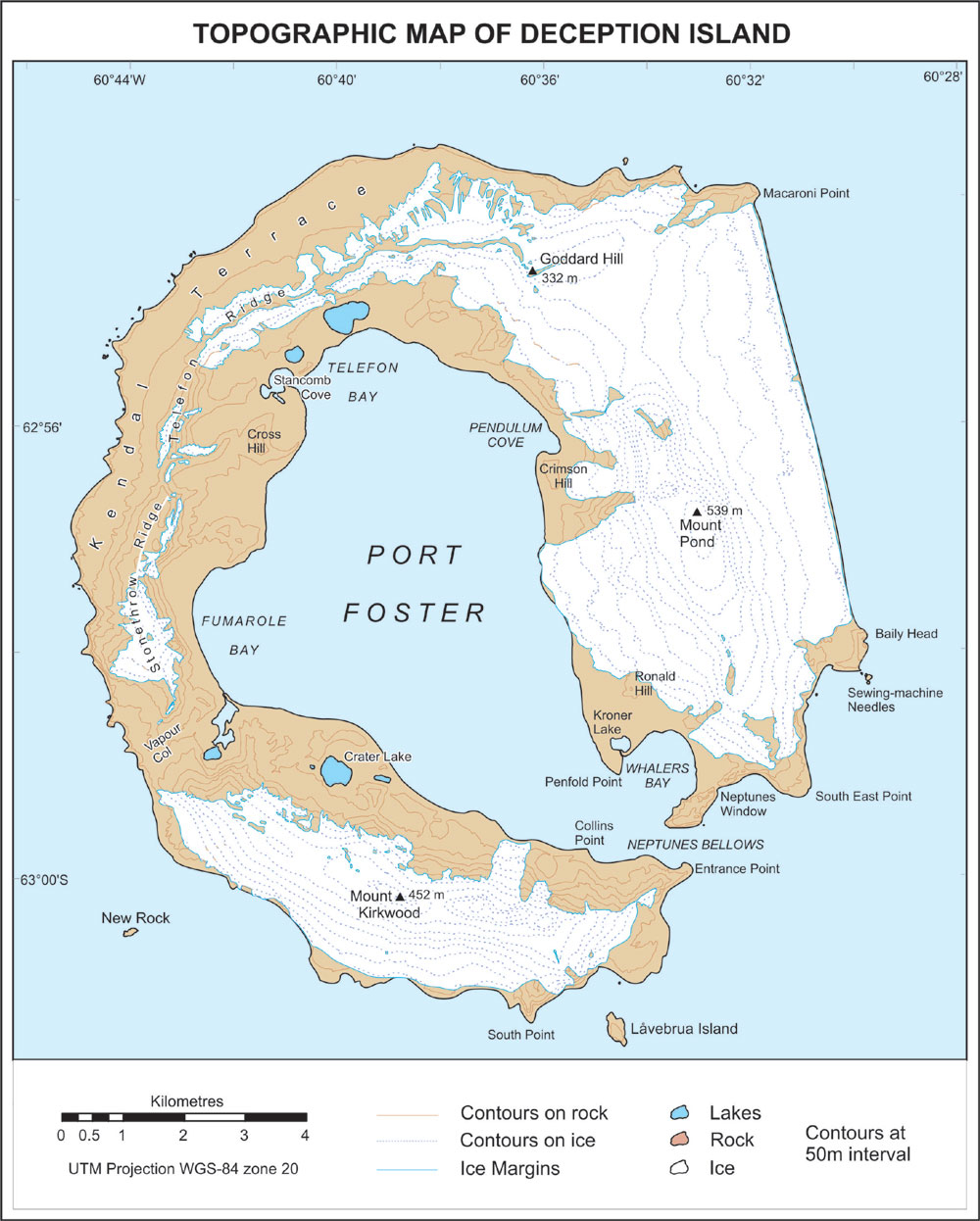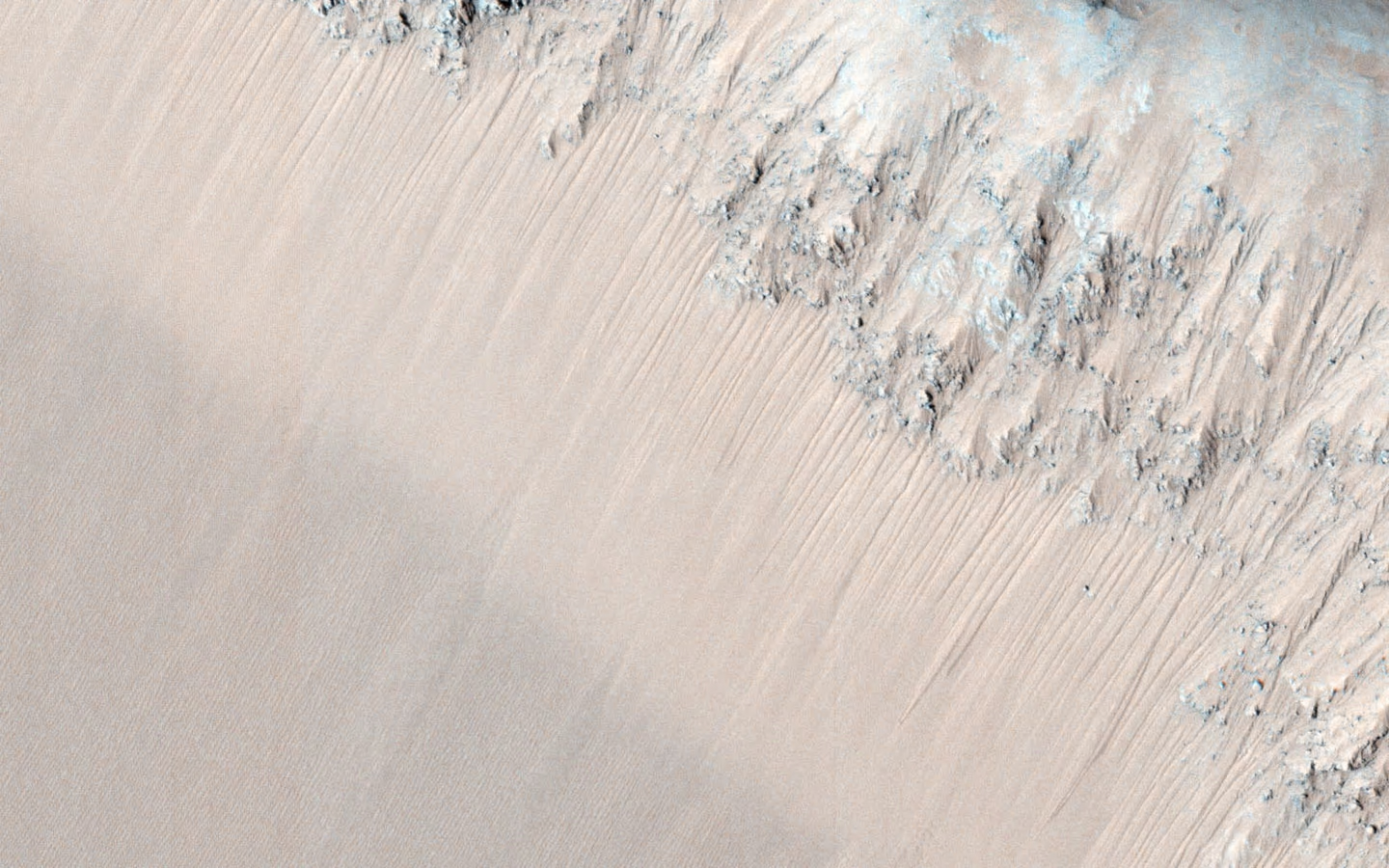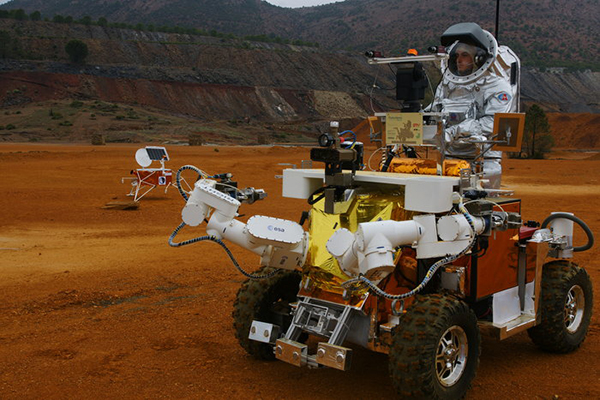Exploring Mars on Earth
The planning of missions to Mars, as well as the optimal scientific exploitation of the huge amount of information those missions provide, need an appropriate contextualization that, obviously, is difficult to achieve without being there. Fortunately, researchers count on many places on Earth where there are some features, processes, environmental conditions etcetera similar enough to get reliable references: the Mars analogue sites.

Credits: University of Texas and NASA respectively
Mars is a preferential target within planetary science field, and some of the most sophisticated spacecrafts have been sent there for exploring in situ different areas of the planet, besides the fleet of orbiters observing from above. In the near future, some others will arrive to go into depth in the main scientific conundrums posed so far, especially the Martian liquid water issue and the assessment of the habitability of the planet. However, nobody is on Mars to give a contextual frame by observing the local environmental, geographical, geochemical or geomorphological circumstances in order to guide the most convenient research to be done and to complete the understanding of the obtained data at a given target location. Yet, Mars and Earth are both rocky inner planets of the Solar System, formed more or less at the same time and with similar materials, only to undergo afterwards evolutions which, although driving to different outcomes, proceeded through the same courses.
This poses the chance of finding on Earth places in which some conditions are the same to those on Mars, and there are a number of them, so that an exhaustive list would be difficult to complete. Of course, none of these analogues shows all the features of Martian surface together, so it is necessary to choose one (or two) with regards to the particular investigation at issue, but it could be said that there is an available Martian like environment on Earth for almost every matter that needs to be studied.
Mars and life related investigations
Perhaps one of the most renowned and best-known places resembling Mars in our planet is Atacama, in Chile, the oldest and driest desert on Earth. It is a vast region by the Chilean pacific coast which meets crucial environmental and geochemical features of Mars. In the first category, are included the extreme aridity, which is even higher than that recorded on Mars, and the UV radiation beating the surface, one of the highest on Earth, though not as severe as that on the Red Planet. In the geochemical chapter, there are two remarkable similarities: the composition of the ground including highly oxidant compounds, and extremely low availability of organic compounds. Despite these harsh conditions, different kinds of microorganisms can be found living in Atacama, offering a perfect scenario not only to test criteria for the habitability evaluation, but to pose hypothesis about the characteristic that presumed Martian life, if any, could have. Studies driven at Atacama can provide clues on how that life could make a living, where are the particular nooks in which it would be more likely for it to thrive, or the way it copes with the lack of liquid water, a requirement that seems to be indispensable for any kind of life that could be imagined.
Currently, the Group of Atmospheric Science is carrying out a campaign at Atacama, LAREX, intended to study certain aspects of the dissemination of microorganisms in the desert, whose results are expected to be applied to the future biological investigations during ExoMars 2020 mission, and in particular those to be performed by HABIT (HAbitability, Brines, Irradiation and Temperature) an instrument which is being developed by the Group of Atmospheric Science (GAS) and that will be part of the mission’s scientific payload. Besides, the study will provide important information for the definition of planetary protection protocols under the light of the new estimations of the possible habitability of Martian surface and subsurface.

Credits: GAS
Another well known Martian like site, which has gained relevance ultimately, is Río Tinto, Spain, again with relation to the search for life mainly. Río Tinto is an extreme acidic environment configured as a result of chemolithotroph activity of organisms feeding on pyrite. Regarding Mars, the interest of this location is that the typical by-products of this metabolic activity, i.e., ferric iron and sulphate, generate in turns minerals such as gypsum, arosite, goethite, and, hematites, all of which have been detected in different locations on Mars (Meridiani Planum) where, as it has been solidly confirmed, ancient basins containing water existed in the past. Therefore, there is a possibility that these places on Mars share a common origin with Río Tinto, so it is worth comparing the results from this latter with those already gathered from similar sites on Mars, and with others that eventually can be obtained in the future, taking into account that the track of past liquid water is one of the factors when choosing landing sites for the upcoming missions. From the available information at Río Tinto, in addition, the evolution of the Martian analogue areas can be reconstructed back to depict their evolution through time.
Coming to the possibility of extant life on Mars, in Río Tinto they have been identified multi-layered deposits containing endolithic micro niches in which photosynthetic eukaryotes and chemolithotroph bacteria thrive protected by a shield of salt from the unbearably acidic exterior. Furthermore, the salts precipitates in Río Tinto contribute to biomineralization, presumably allowing the preservation of organics, what could entail especial interest when searching for signs of past life on Mars. In this sense this exceptional Mars analogue is optimal for the development of techniques for the identification of micro niches within salty sedimentary deposits by means of robotic vehicles during space missions.
Martian-like landscapes
The two Mars analogue sites mentioned so far show mainly geochemical and environmental similarities but, when looking for geomorphological and thermal resemblances, it is necessary to look elsewhere and, again, several areas are available for exploring Mars on Earth in this sense.

To give a less known but notable example, the Deception Island, in the Antarctic Peninsula can be cited. It is a young active volcano (its last eruption was registered in 1970), so it keeps well preserved volcanic features whose study can cast light on the comprehension of the vast volcanic regions on Mars. Deception Island, in summary, shows general landforms (lava flows, mound, hills and small plateaus…), volcanic materials, ice related features (ice caps, glacier tongues covered by pyroclastic regolith like is common on Mars ice deposits…), permafrost and, importantly, water ice related features like gullies and other slope features that ultimately have acquired a great relevance in the study of Mars surface dynamics.
Another outstanding Mars analogue regarding geomorphology is Devon Island, Canada, an uninhabited island which holds the Haughton crater, the only impact crater in a polar region. Its characteristics make out of this site a unique Mars analogue, where it is possible to find a series of potential geologic and geomorphic analogues, in particular glacial meltwater channels, glacial trough valleys, glacial deposits, paleolacustrine deposits, and periglacial patterned ground.
Some other places could could be still mentioned (Dry valleys of Antarctica, Desierto de La Joya…) and the list is not closed yet.
Whereas the commented places so far are similar to Mars in a more or less broad sense, there are cases in which the similarity is limited to a particular process occurring in the same circumstances it is thought that mark its development there. That is the case of Tekirova, Turkey, where a zone of ophiolites (a kind of rocks that are thought to be an uplifted section of the oceanic crust) has been found. These rocks suffered a series of reactions known as serpentinization, basically consisting of a process of hydration of crust materials in contact with water, and the resultant materials at Terikova are undergoing currently reactions which produce a substantial amount of methane in a process that, thanks to the concurrence of certain catalyst minerals, takes place even at low temperatures. Then, the gas escapes through fractures of the terrain, reaching the atmosphere eventually. It has been proposed that, on Mars, similar processes could be taking place, since the presence of similar serpentinized rocks and catalysts is common, offering a possible abiotic explanation for the mysterious raisings of methane registered on the planet’s atmosphere. The investigations being carried out at Terikova, therefore, will provide a chance of testing this hypothesis for its further extrapolation to Mars.

Credits: NASA
But, after the report of the occurrence of transient liquid water on Martian ground, some known dynamic topographic features of Mars surface have been tried to be linked to the phenomenon, in particular the Recurrent Slope Lineae (RSL) and the Slope Streaks, triggering the search for new places in which this or similar processes take place on Earth, to get references and information that help either to confirm or to discard the hypothesis, controversial for the time being, that deliquescence is the root cause of them. And indeed, they are being sought.
Apart from the previous scientific studies all these Mars analogues permit to perform, they are useful also in the engineering and operational aspects of the missions to be rehearsed. Among the numerous campaigns carried out in this sense, it could be mentioned the testing of Curiosity rover in Mohave desert to check the performance of its wheels in sand dunes, a very common topographic feature on Mars which can mean a fatal trap. For the testing of the instruments composing its scientific payload, it was necessary to go to places in which particular conditions, regarding the measurements to be gathered by the different instruments, can be found.
HABIT itself has been submitted to several field site campaign tests since the very first step of its development. Different prototypes have been carried to Iceland, Ladakh (India), and the Boulby Mine (UK), all of them locations offering some environmental resemblance with Mars, where the performance of the instrument has been progressively improved. The last two campaigns were framed in the wide NASA’s Spaceward Bound programme, established in 2006 to train the next generation of space explorers through the exploration of scientifically interesting but remote and extreme environments on Earth as analogues for human exploration of the moon and Mars. Along the same lines, NASA drives the Haughton Mars Project at Devon Island, an international interdisciplinary field research facility meant to mimic the environmental conditions that crewmembers are likely to encounter on Mars.

Credit: ESA.
ESA, for its part, is carrying out training programmes aiming to the preparation of teams for future manned missions to Mars (among other destinations like the Moon or asteroids). The PANGAEA programme is meant to replicate a whole mission, from astronauts’ operations to the support provided by the control team. Roberto Mantas Nakhai, member of the GAS, is currently participating within this programme in the development of a new data processing system for the optimal real-time guidance of the astronauts’ activities during such a mission, in order to maximize the scientific outcomes obtained.
Nevertheless, despite all that has been said so far, it must be advised that there are two Martians conditions which are unreachable on Earth (apart from the lowest temperatures registered there): the atmospheric pressure and the gravity. Whereas the earlier can be reproduced in the labs for conducting experiments within atmospheric simulation chambers, the latter is impossible to replicate on Earth in any way. And, regarding the course of some processes, among which precisely the formation of RSLs and Slope Streaks stand out, gravity can play a crucial role which is difficult to estimate. The only way of modulating the value of the gravity is to resort to parabolic flights, during which experiments can be driven under the appropriate gravitational conditions for a few seconds; another method of implementing an instant Mars analogue inside an airplane.
All in all, the investigations at Mars analogue sites permit to optimize the planet’s related investigations, from the selection of scientific targets to the analysis of results though, at last, the ultimate goal keeps on being to go there to perform the proper explorations.


Comentarios
Publicar un comentario